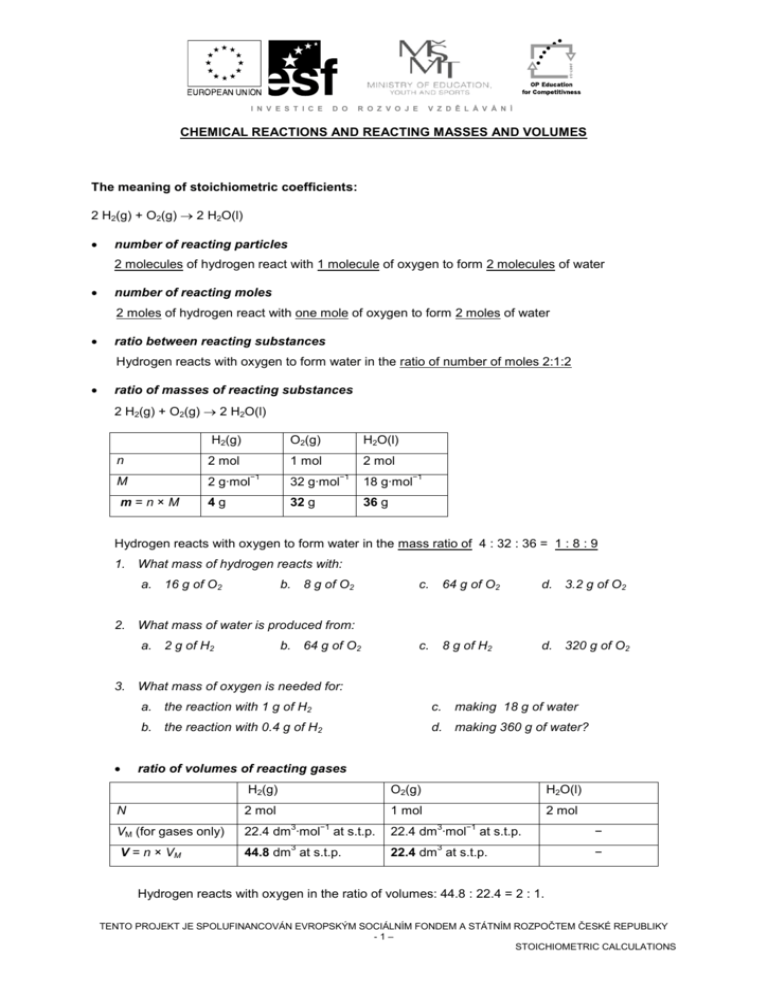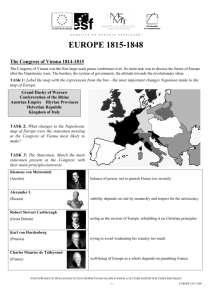CHEMICAL REACTIONS AND REACTING MASSES AND
advertisement

I N V E S T I C E D O V Z D Ě L Á V Á N Í R O Z V O J E CHEMICAL REACTIONS AND REACTING MASSES AND VOLUMES The meaning of stoichiometric coefficients: 2 H2(g) + O2(g) 2 H2O(l) number of reacting particles 2 molecules of hydrogen react with 1 molecule of oxygen to form 2 molecules of water number of reacting moles 2 moles of hydrogen react with one mole of oxygen to form 2 moles of water ratio between reacting substances Hydrogen reacts with oxygen to form water in the ratio of number of moles 2:1:2 ratio of masses of reacting substances 2 H2(g) + O2(g) 2 H2O(l) H2(g) n O2(g) 2 mol H2O(l) 1 mol −1 2 mol −1 −1 M 2 g∙mol 32 g∙mol 18 g∙mol m=n×M 4g 32 g 36 g Hydrogen reacts with oxygen to form water in the mass ratio of 4 : 32 : 36 = 1 : 8 : 9 1. What mass of hydrogen reacts with: a. 16 g of O2 b. 8 g of O2 c. 64 g of O2 d. 3.2 g of O2 c. 8 g of H2 d. 320 g of O2 2. What mass of water is produced from: a. 2 g of H2 b. 64 g of O2 3. What mass of oxygen is needed for: a. the reaction with 1 g of H2 c. making 18 g of water b. the reaction with 0.4 g of H2 d. making 360 g of water? ratio of volumes of reacting gases H2(g) N O2(g) 2 mol H2O(l) 1 mol 3 −1 VM (for gases only) 22.4 dm ∙mol V = n × VM 44.8 dm at s.t.p. 3 at s.t.p. 2 mol 3 −1 22.4 dm ∙mol at s.t.p. 3 22.4 dm at s.t.p. − − Hydrogen reacts with oxygen in the ratio of volumes: 44.8 : 22.4 = 2 : 1. TENTO PROJEKT JE SPOLUFINANCOVÁN EVROPSKÝM SOCIÁLNÍM FONDEM A STÁTNÍM ROZPOČTEM ČESKÉ REPUBLIKY -1– STOICHIOMETRIC CALCULATIONS I N V E S T I C E D O R O Z V O J E V Z D Ě L Á V Á N Í 4. What volume of hydrogen is needed for the reaction with: 3 a. 4 dm of O2 3 b. 100 dm of O2 c. 3 30 dm of O2? 5. What volume of oxygen is needed for the reaction with: 3 a. 60 dm of H2 3 b. 15 dm of H2 c. 3 100 m of H2? H2(g) O2(g) H2O(l) n 2 mol 1 mol 2 mol M 4g 32 g 3 V 44.8 dm at s.t.p. 36 g 3 22.4 dm at s.t.p. − 6. What volume of O2 (at s.t.p.) reacts with: a. 4 g of H2 b. 2 g of H2 c. 12 g of H2? 7. What volume of H2 (at s.t.p.) is needed for making a. 9 g of H2O b. 360 g of H2O? 8. What mass of oxygen reacts with: 3 a. 22.4 dm of H2 3 b. 11.2 dm of H2 c. 3 89.6 dm of H2? (at s.t.p.) 9. What mass of water is made from: 3 a. 224 dm of O2 3 b. 11.2 dm of H2? (at s.t.p) Stoichiometric calculations Calculating the mass: Worked example: How many grams of silver may be displaced from a silver nitrate solution using 4 g of zinc ? Method A Write down and balance the equation of the reaction: Give the ratio between the number of moles of Zn and Ag: .... AgNO3 + ... Zn ... Zn(NO3)2 + ... Ag ........ mol ........mol TENTO PROJEKT JE SPOLUFINANCOVÁN EVROPSKÝM SOCIÁLNÍM FONDEM A STÁTNÍM ROZPOČTEM ČESKÉ REPUBLIKY -2– STOICHIOMETRIC CALCULATIONS I N V E S T I C E D O V Z D Ě L Á V Á N Í R O Z V O J E ......× 65.4 = ........ g Give the mass ratio of zinc and silver using the ratio of number of moles: ..... × 108 = ........g .......... g ......... g Write down the masses you know from the question: x= Use the mass ratio to calculate the mass of silver: The mass of displaced silver is 13.21 grams. Method B Write down and balance the equation of the reaction: 2 AgNO3 + Zn Zn(NO3)2 + 2 Ag Calculate the number of moles of reacting zinc using its mass and the molar mass: nZn = mZn/MZn = Use the stoichiometric coefficients to calculate the number of nAg = ..... × nZn = .......... mol moles of displaced silver: Calculate the mass of displaced silver using the number of mAg = nAg × MAg = moles and its molar mass: 10. Use both above described methods to calculate how many grams of sodium sulphate may be made by the neutralization of 5.8 g of sodium hydroxide. Calculating the volumes of reacting substances: Worked example: Calculate the volume of carbon dioxide (at s.t.p.) displaced from 1000 g of limestone. Method A Method B CaCO3 + 2HCl CO2 + H2O + CaCl2 CaCO3 + 2HCl CO2 + H2O + CaCl2 3 ......... g ....... dm ......... g ........ dm x= 3 ... from the question nCaCO3 = m CaCO3/M CaCO3 = ... from the equation nCO2 = ..... n CaCO3 = VCO2 = nCO2 × VM = 11. Calculate the volume of hydrogen sulphide gas (at s.t.p.) prepared from 100 g of iron (II) sulphide by a reaction with hydrochloric acid. TENTO PROJEKT JE SPOLUFINANCOVÁN EVROPSKÝM SOCIÁLNÍM FONDEM A STÁTNÍM ROZPOČTEM ČESKÉ REPUBLIKY -3– STOICHIOMETRIC CALCULATIONS I N V E S T I C E D O R O Z V O J E V Z D Ě L Á V Á N Í Calculating the number of moles: Worked example: What number of moles of HCl is needed for the neutralization of 8 g of Ca(OH)2? Method A Method B ..... Ca(OH)2 + ..... HCl ..... CaCl2 + ..... H2O ..... Ca(OH)2 + ..... HCl ..... CaCl2 + ..... H2O ........g ..... moles ... from the question n Ca(OH)2 = m Ca(OH)2 /M Ca(OH)2 = ....... g ..... moles ... from the equation nHCl= ..... × nCa(OH)2 x= 12. What`s the number of moles of ammonia prepared from 12 grams of nitrogen? Questions: 1. A solution containing potassium iodide is precipitated with the excess of silver nitrate forming 2.43 g of silver iodide. What is the mass of potassium iodide present in the solution? 2. What mass of calcium carbonate is needed for making 2 kg of quick lime (calcium oxide)? 3. What mass of potassium hydroxide is needed for the preparation of 3.4 g of potassium sulphate? 4. Chromium may be prepared from chromium (III) oxide using aluminium as a reducing agent. Calculate what mass of aluminium is needed for preparation of 0.1 kg of chromium. What mass of aluminium oxide is made this way? 5. What mass of glucose is made from 85 g of carbon dioxide by photosynthesis? 6. What mass of sodium ethanoate may be prepared by neutralization of 100 g of ethanoic (acetic) acid? 7. Calculate the mass of water made by burning 12 g of ethanol. 8. What`s the number of moles of hydrogen chloride prepared from 7.09 g of chlorine. 9. Calculate the number of moles of water needed to make 20 g of glucose during photosynthesis. 10. Calculate what mass of calcium hydroxide reacts with 0.257 moles of hydrogen chloride. 11. Calculate the number of moles of oxygen reacting with 250 g of hydrogen to form water. 12. What`s the volume of ammonia prepared from 15 litres of hydrogen (at s.t.p.)? 13. Calculate the volume of hydrogen displaced from sulphuric acid by 7.9 g of aluminium (at s.t.p.). 14. How many grams of potassium chlorate (VII) is needed for the preparation of 2 litres of oxygen (at s.t.p.) by its thermal decomposition? (The second product is potassium chloride.) 15. Calculate the volume of carbon dioxide at s.t.p. made by complete combustion of 1 kg of 2,2,4-trimethylpentane. 16. Potassium permanganate (manganate (VII)) decomposes when heated to potassium manganate (manganate (VI)), manganese (IV) oxide and oxygen. Calculate the mass of potassium permanganate needed for preparation of 0.8 l of oxygen. 17. What mass of sodium hydrogen carbonate is needed for the neutralization of 200 ml of 0.1M sulphuric acid? TENTO PROJEKT JE SPOLUFINANCOVÁN EVROPSKÝM SOCIÁLNÍM FONDEM A STÁTNÍM ROZPOČTEM ČESKÉ REPUBLIKY -4– STOICHIOMETRIC CALCULATIONS I N V E S T I C E D O R O Z V O J E V Z D Ě L Á V Á N Í 18. What mass of calcium hydroxide is needed for the neutralization of 30 g of 35% hydrochloric acid? What mass of calcium chloride will be made this way? -3 19. What volume of 96% sulphuric acid (ρ = 1.8 g∙cm ) is needed for the neutralization of 16.4 g of sodium hydroxide? 20. 200 g of 3% solution of sodium hydroxide reacts completely with iron (III) chloride to make a precipitate of iron (III) hydroxide. What is its mass? 21. What`s the volume of oxygen prepared from 150 g of 30 % solution of hydrogen peroxide (at s.t.p.)? 22. Calculate the volume of carbon dioxide which may be evolved from sodium hydrogencarbonate -3 using 10 ml of 96 % sulphuric acid (ρ = 1.8 g∙cm ) (at s.t.p.). 23. Calculate the volume of chlorine (at s.t.p.) made from 150 g of 20% solution of sodium chloride during electrolysis. -3 24. What volume of 36 % hydrochloric acid (ρ = 1.2 g∙cm ) is needed for dissolving 8 g of limestone (calcium carbonate)? What volume of carbon dioxide (at s.t.p.) is evolved during this reaction ? What number of moles of water and what mass of calcium chloride is made this way? Answers: 1. 2. 3. 4. 5. 6. 7. 8. 9. 10. 11. 12. 13. 14. 15. 16. 17. 18. 19. 20. 21. 22. 23. 24. 1.72 g 3571.4 g 2.2 g 52 g, 98 g 57.9 g 136.7 g 14.1 g 0.2 mol 0.667 mol 9.5 grams 62.5 mol 3 10 dm 3 9.83 dm 6.18 g 3 1572 dm 11.29 g 3.36 g 10.64 g, 15.97 g 11.6 ml 5.35 g 3 14.82 dm 3 7.9 dm 3 5.74 dm 3 13.5 ml, 1.79 dm ,1.44 mol, 8.88 g TENTO PROJEKT JE SPOLUFINANCOVÁN EVROPSKÝM SOCIÁLNÍM FONDEM A STÁTNÍM ROZPOČTEM ČESKÉ REPUBLIKY -5– STOICHIOMETRIC CALCULATIONS









